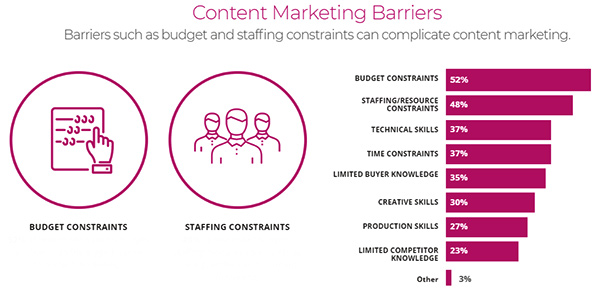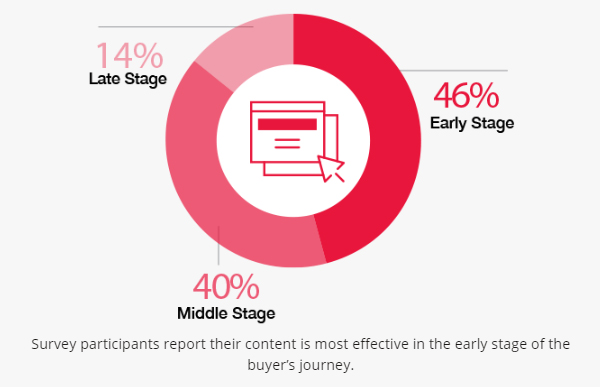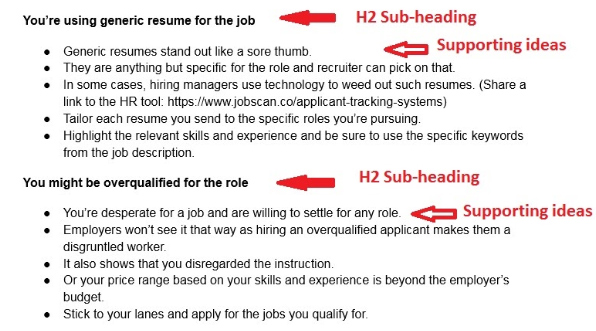Did you know only 30% of marketers are happy with the results of their content marketing efforts? Well, this can serve as a reality check for anyone who’s been putting money into content creation to no avail.
So, what’s the catch? The Content Marketing Institute’s 2016 survey gives us some valuable insights.
It turns out the main culprit to blame is the fact that businesses can’t satisfy the growing demand for content. According to the research above, 57% of survey respondents claim they struggle to produce content consistently.
Now, let’s look at the chart to consider other main content marketing challenges.
- 30% of marketing professionals feel their organization is effective at content marketing
- 60% of marketers cite producing engaging content as a key challenge
- 57% percent struggle to produce content consistently
- 51% percent cite lack of time and bandwidth as a major hurdle
Many marketers are guilty of skipping this step. But writing outlines is a great strategy if you want to streamline your content creation.
Today, we’ll teach you how to do it. Faster and simpler.
What Are the Barriers to Effective Content Marketing?
As a Content Marketer or a CMO, you need to know what hinders your content marketing efforts. Identifying the hurdles will give you something to work with. You’ll be able to strategize better.
As mentioned above, many businesses and marketing professionals blame the lack of time for less-than-satisfying content marketing results. Yet other factors play an important part as well.
Demand Metric’s 2018 Benchmark Study found that staffing and resource constraints are the main content marketing barriers.
Here’s a list of other important barriers presented in the same study.

In a nutshell, if you want your content strategy to work, you need to create a constant stream of quality content. And you need to put in enough time, money and effort to do this.
And luckily, you can outsource some of your content creation too.
How to Write Outlines to Help Streamline Your Content Creation
It’s simple. Writing an outline can help you create engaging, quality content at a faster pace. How’s that? Because each content piece you create will be well-thought-out beforehand.
And it gets better. Outlining a blog post helps you rev up the writing process itself.
Think of it this way. It’s well worth spending extra 20-something minutes on laying out an outline if it’s going to step up your content creation. Makes sense, right?
Once a writer drafts an outline, they can follow the cues and expand on each idea in the writing process. Plus it’s much easier to write when you’ve already gained momentum in the prewriting stage.
So, let’s dive right in.
Today we focus on how to write a blog post outline to ramp up your content creation.
Write an Outline With Your Buyer Persona in Mind
Writing a blog post from scratch is a difficult thing to do. But if you have a clear idea about who your target audience is, your brain starts making connections. And before you know it, there you are getting torrents of ideas about what to write about in your post.
This is a great way to kick off your writing process and it’s pretty simple. Visualize your buyer persona. Then strike up an imaginary conversation with it.
When you put a name to a face, you’ll find it much easier to figure out what content your readers want you to create.
It’s only when you’re able to understand your audience that you’re able to create engaging content. And only engaging content can drive major ROI.
It’s only when you’re able to understand your audience that you’re able to create engaging content. And only engaging content is able to drive a major ROI.
So, use the outlining phase to sketch a quick buyer persona. Create their demographic profile and highlight the major pain points.
Here are some points to think about:
- Background. What’s their career path? How many years of working experience do they have? What’s their marital status? Do they have kids?
- Demographics. Here you want to have a rough idea about their sex, income, age, and location.
- Identifiers. What’s their communication style and demeanor?
- Goals. Why are they seeking information within your niche? What do they want to resolve?
- Challenges. What are their immediate pain points?
- Solutions. What can you do to help them achieve their goals and rise to their challenges?

Identify the Ideal Buying Stage
While the audience is still on your radar, you might as well determine their ideal buying stage. After all, how can you influence your customers during their buyer’s journey if you’re clueless about where they’re at?
So, give this a little thought when you’re writing an outline. You’ll get a better idea about what content your audience wants at different stages of awareness.
Now, let’s have another look at the above mentioned Demand Metric’s study. It found that 46% of respondents believe their content is the most effective in the early buying stages.

Your top-of-the-funnel (ToFu) audience is still getting to know your product and is looking for some industry-specific answers. So, you should tailor your ToFu content to deliver those answers.
This is where you’ll show your audience how your product can solve their problems.
You’ll also want to target your content to your middle-of-the-funnel and bottom-of-the-funnel audience. As they move further into the evaluation and purchase stages, people want to hear more about how your product compares to other products on the market.
But you’ll be up to the task. You’ll have it all figured out in the pre-writing stage!
Create a List of Relevant Questions
Now you have an idea about your target audience and the potential ways to move them through your sales funnel.
These insights make it easier for you to step into your readers’ shoes. Which means you’ll be able to understand them better.
And now comes the fun part!
Start writing your blog post outline by giving yourself a freestyle brain exercise of sorts. The goal is to come up with as many potential questions as your readers might have on the topic.
Since you know enough about your reader and your niche, this step should be a no-brainer. Just keep the questions coming, even if you don’t have all the answers at the moment.
You’ll figure that out in the research phase.
Now, let’s say you’re writing an article about why it is so hard to find an online job. Here are some questions people might want answers to regarding the topic at hand.
- How to write a resume that will help me land a job?
- How do I become a competitive candidate for an online job position?
- Do I need to have work experience to lend an online job?
- What if I’m overqualified for the job role?
- What if I’m underqualified for the job role?
- Do I need to have a strong portfolio to apply for online writing jobs?
- How to find industry-relevant, up-to-date online courses?
Now you have a great starting point for your article.
Organize Your Ideas Into a Standard Outline Format
At this point, you’ll want to take your readers’ questions and convert them into a list of main and supporting ideas. Use the standard online format to organize your points.
While expanding on your ideas, make sure you include information that’s useful to your reader:
- Teach them a beneficial new skill.
- Share an insightful piece of research.
- Pack your copy with on-point examples.
- Share tools and tips that have helped you overcome an issue.
The result is value-added content. Bingo! It’s what both you and your audience need.
Create a list of subheadings and bullet points and use it as a map to navigate the writing process. Put your main points into H2 headings and organize your supporting points in the bullet format. These will evolve into paragraphs.
You can expand your outline structure to include H3 and H4 headings if the article’s more in-depth.

And remember, pack your outline with relevant research and authority quotes from experts. Data-based content is winning content.
Start Scaling Your Content Today
Everyone wants to be rewarded for their content marketing efforts. But the truth is, this rarely plays out in practice. At least not on a massive scale.
You need to pair an effective content marketing strategy with a solid flux of regular blog content. Only then can you expect any tangible results (more traffic, user engagement, and sales).
Writing blog post outlines can help streamline your content creation. As well as keep your content quality in check.
But if you want to make things simple, there’s another way. Hire a content creation company to do the hard work for you.
